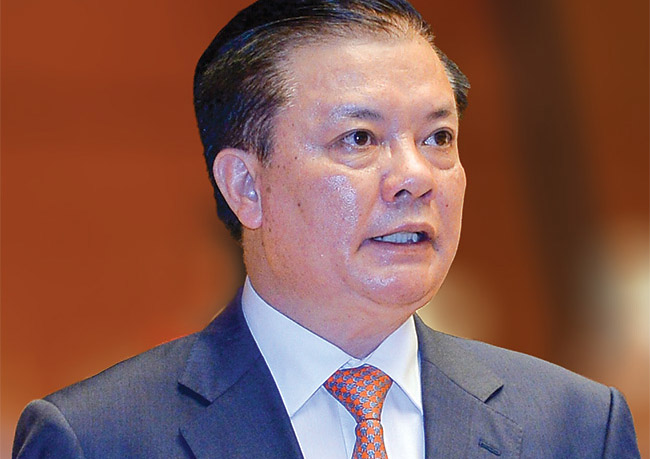Government bonds profit from surge in interest
 |
We are about to reach the government bond mobilisation target for 2016, but it seems we’re falling short when it comes to the disbursement target. What is your assessment?
Though interest rates in the monetary market were in an upward trend, we successfully raised VND187.7 trillion ($8.57 billion) in government bonds in the first half of this year, reaching 83 per cent of the year’s target.
The spending of state budget capital and government bonds for investment during the period, however, proceeded at a fairly slow pace. We only achieved 23 per cent of the target.
The National Assembly Financial and Budgetary Committee commented that the government bond’s slow disbursement pace has caused waste in resources. Is that true?
Theoretically, mobilised capital is a loan that goes parallel to an associated interest rate; so that large raised volumes versus low disbursement rates means a waste of resources. But in fact, this is not true when it comes to the government bond mobilisation and disbursement.
For instance, of the VND187.7 trillion ($8.57 billion) government bond volume we have raised in the year to date, VND82 trillion ($3.67 billion) was disbursed, another VND23 trillion ($1.05 billion) carried forward from mobilised government bond volume in 2015 was also disbursed, while another VND66.6 trillion ($3.04 billion) was used to pay for the bonds mobilised in the previous years. That means only about VND16 trillion ($730 million) in government bonds was left unused, equal to 8.5 per cent of total raised volume. That left sum is reasonable because state budget spending is like household spending; we need to keep some money in stock for unexpected expenses.
You said that government bond usage this year was more efficient than last year. Could you elaborate?
This is due to the fact that the government bond average interest rate has been dropping significantly in recent years. The rate stood at 6.81 per cent and 6.34 per cent per year in 2014 and 2015, respectively, compared to 11.9 per cent per year in 2012, 10.03 per cent in 2013, and 7.96 per cent in 2014. In the first six months this year, it was at around 6.4 per cent per year, with an average maturity of 6.8 years. Using mobilised government bonds at lower interest rates to pay for previous debts that require higher interest rates from 10 to 11 per cent per year has proven efficient.
Besides, the average government bond maturity has increased to 6.8 years in the first six months of this year. The volume of bonds having maturity from 10 to 15 years has been on the rise, extending total government bond average maturity to 5.04 years – a remarkable increase from an average bond maturity of only 2.8 years in 2013, 3.1 years in 2014, and 4.4 years in 2015.
What measures has the Ministry of Finance taken to extend bond maturity in the long haul?
We have worked with Vietnam Social Security (VSS) to turn all funding the state budget will borrow from VSS into bonds. Estimates show that VSS could start having deficits from 2023, meaning that state budget borrowing from VSS will have at least a seven year maturity. When this sort of funding is turned into bonds, average government bond maturity will be further extended from 7 to 10 years.
At present, local commercial banks hold about 80 per cent of the government bond volumes. When VSS funding turns into bonds, and incentive policies are applied to attract insurance firms, insurance and pension funds to join the government bond market, the government bond volume kept by commercial banks will decrease to only about 50 per cent. This will pave the way for the bond and monetary markets to develop in a healthier way.
What the stars mean:
★ Poor ★ ★ Promising ★★★ Good ★★★★ Very good ★★★★★ Exceptional
Latest News
More News
- Industrial sector posts robust gains as year-end demand rises (December 09, 2025 | 13:38)
- ASEAN economies move up the global chip value chain (December 09, 2025 | 13:32)
- Reforms urged to unleash private-sector power (December 07, 2025 | 09:00)
- Foreign-invested enterprises export $295.6 billion in January-October (December 06, 2025 | 11:43)
- Bespoke policies to fast-track key developments in Hanoi (December 06, 2025 | 11:40)
- Vietnam targets higher value chains as global production reshapes (December 05, 2025 | 13:54)
- Hanoi and Mekong Delta set for major boost as new infrastructure projects break ground (December 05, 2025 | 13:42)
- Vietnam and Laos commit to joint industrial development and research (December 03, 2025 | 19:08)
- Vietnam Expo 2025: a strategic move for Hong Kong into Southeast Asia’s rising star (December 03, 2025 | 18:50)
- Vietnam sets pace for dual transition in industry and trade (December 03, 2025 | 14:12)


















 Mobile Version
Mobile Version